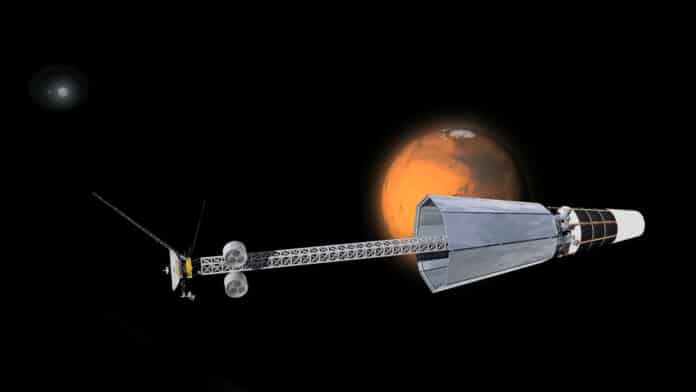Lockheed Martin received a $33.7 million contract from the Air Force Research Laboratory (AFRL) for the Joint Emergent Technology Supplying On-Orbit Nuclear (JETSON) High Power program to mature high-power nuclear electric power and propulsion technologies and spacecraft design.
As space missions continue to explore the outer solar system and extend their durations, finding new ways to power and propel spacecraft becomes crucial. Chemical rockets and solar panels have been the go-to technologies for more than six decades, but they are already near their theoretical limits and can barely reach Jupiter.
For missions that go further than Jupiter, nuclear power is needed to operate the spacecraft systems. Chemical rockets in that region can only propel spacecraft by limiting payloads and using complex slingshot orbits to build up the necessary velocity to reach their destination.
Lockheed’s JETSON project, in partnership with Space Nuclear Power Corp and BWX Technologies, will address the escalating need for advanced spacecraft mobility, situational awareness, and power generation that far surpasses traditional spacecraft capabilities. It aims to combine a nuclear fission reactor with electric propulsion Hall thrusters that are used on Lockheed Martin’s LM2100 satellites.
JETSON will utilize a fission reactor that generates heat, which is then transferred to Stirling engines to produce between 6 kWe and 20 kWe of electricity. This is four times more powerful than conventional solar arrays and does not require continuous exposure to sunlight.
The reactor’s design and functionality are based on the 2018 Kilopower Reactor Using Stirling Technology (KRUSTY) demonstration, which was led by NASA and the DoE’s National Nuclear Security Administration. KRUSTY demonstration uses solid-cast uranium 235 reactor core for fuel surrounded by a beryllium oxide reflector, which prevents neutrons from escaping the reactor core and allows the chain reaction to continue.
This technology has the potential to produce much higher electrical output than spacecraft powered by solar panels, which typically generate about 600 watts of power. This makes nuclear electric-powered subsystems a great alternative to have in a company’s power-generation toolkit for deep space exploration missions that are not as close to the sun or in shadowed regions.
As with other space nuclear programs, safety is of utmost importance for JETSON. The uranium fuel is harmless before it undergoes fission. The reactor is dormant and inactive during launch, and it only activates when the spacecraft reaches a stable and distant orbit away from Earth.
The project serves as a critical step forward in using nuclear electric propulsion to get humans to the Moon, Mars, and beyond. It is currently in the preliminary design phase and could proceed to the critical design review if approved. The aim is to create a propulsion system that can enable faster and more efficient missions to the outer solar system and beyond.
“Nuclear fission development for space applications is key to introducing technologies that could dramatically change how we move and explore in the vastness of space,” said Barry Miles, JETSON program manager and principal investigator at Lockheed Martin. “From high-power electrical subsystem and electric propulsion to nuclear thermal propulsion or fission surface power, Lockheed Martin is focused on developing these systems with our important government agencies and industry partners.”
